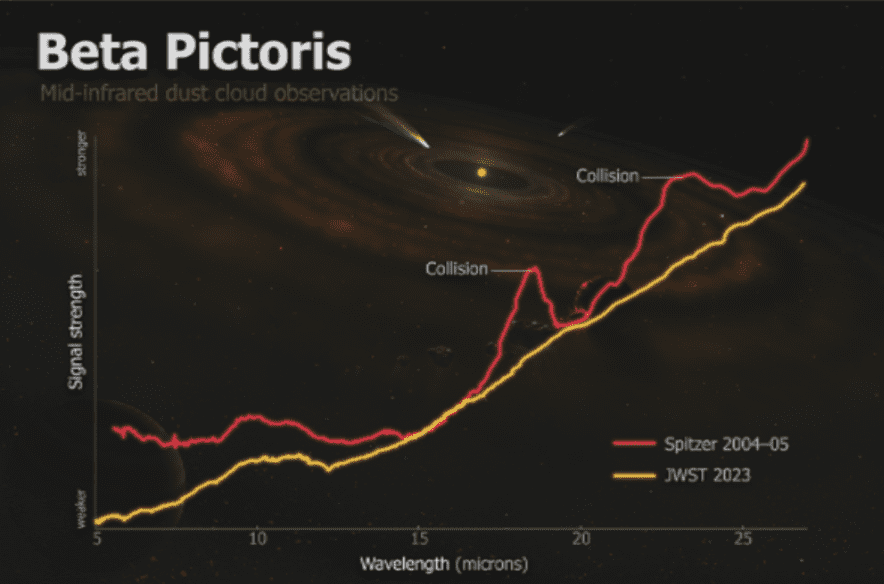The James Webb Space Telescope (JWST) has observed evidence indicating that asteroids are colliding in a neighboring star system. The resulting dust kicked up by the collision has a mass equal to approximately 100,000 times that of the asteroid that killed the dinosaurs.
The asteroids were observed colliding in Beta Pictoris, a star system located approximately 63.4 light-years from the solar system. This star system is notable for its relative youth, with an estimated age of 20 to 25 million years. This makes it a celestial infant in comparison to our 4.6 billion-year-old solar system. The fact that Beta Pictoris is still in the early stages of planetary formation means that the JWST’s observation of colliding asteroids within this star system could shed light on the volatile processes that shaped planetary systems like the solar system in their infancy.
“Beta Pictoris is at an age when planet formation in the terrestrial planet zone is still ongoing through giant asteroid collisions. Consequently, what we could be observing here is the process of rocky planet and other body formation in real time,” stated team leader Christine Chen, an astronomer at Johns Hopkins University, in a press release.
The JWST observed changes in the vicinity of Beta Pictoris
Although the solar system and Beta Pictoris are relatively close, the distance between them is sufficiently large to render the direct observation of asteroids colliding in the latter an extremely challenging endeavor. Moreover, the distance between the solar system and Beta Pictoris is such that one would have to observe a collision in the dusty torus of gas and dust surrounding the young star, which is known as a “protoplanetary disk.”
To achieve this detection, Chen and colleagues compared new data from the JWST with observations collected by the Spitzer Space Telescope between 2004 and 2005. This revealed significant changes in the energy signatures of dust grains around Beta Pictoris, with a particular focus on the heat emitted by minerals commonly found around young stars, as well as on Earth. These are referred to as “crystalline silicates.”
The comprehensive observations conducted by the JWST enabled the research team to investigate the presence of dust particles in the vicinity of Beta Pictoris, a region previously explored by the Spitzer Space Telescope. The team found no evidence of the particles observed by Spitzer two decades ago. This indicated that a cataclysmic collision between asteroids or other objects in the vicinity of Beta Pictoris had occurred approximately 20 years ago. Such an impact would have pulverized these bodies, transforming them into a shower of particles as fine as powdered sugar.
Chen posited that the dust observed in the Spitzer data from 2004 and 2005 is consistent with the initial observations. “With the JWST’s new data, the most plausible explanation is that we observed the aftermath of an infrequent, cataclysmic event between large asteroid-size bodies, which represents a significant shift in our understanding of this star system.”
The absence of asteroid-collision dust in the JWST images can be attributed to the dispersal of such particles by radiation from the star Beta Pictoris. The emissions observed by Spitzer 20 years ago represented the initial stages of this process, during which the dust was subjected to heating by stellar radiation and emitted thermal energy. Furthermore, the dust has cooled as a result of its distance from the central star, which has ceased to emit thermal energy.
Previously, Spitzer’s observations of the region were assumed to be the result of small bodies around Beta Pictoris grinding down and replenishing the dust over time. However, the JWST data indicates that the replenishment of this dust is not occurring when it is kicked away by the central star.
The relative proximity of Beta Pictoris, which is known to host two young exoplanets, and its youth have made this planetary system a prime target for astronomers attempting to understand the processes that govern planetary formation.
The question we are attempting to contextualize is whether this process of terrestrial and giant planet formation is common or rare, and the even more basic question: “Are planetary systems like the solar system that rare?” asked team member Kadin Worthen, a doctoral student in astrophysics at Johns Hopkins. “The objective is to ascertain whether our planetary system is an anomalous or a typical example.”
This new research demonstrates the JWST’s capacity to investigate the intricacies of planetary systems and extrasolar planets, or “exoplanets.” The $10 billion space telescope could assist in elucidating the circumstances under which planetary systems assume a configuration analogous to that of the solar system and, conversely, exhibit diverse morphologies.
Furthermore, the JWST may assist astronomers in elucidating the influence of early turbulence around stars on the atmospheres, water content, and other pivotal aspects of planetary habitability.
“The majority of discoveries made by the JWST are a direct result of the telescope’s observations,” stated team member Cicero Lu, a former doctoral student in astrophysics at Johns Hopkins University. “In this instance, the narrative differs somewhat, as our findings pertain to phenomena that the JWST was unable to observe.”
The team presented their findings on Monday, June 10, at the 244th Meeting of the American Astronomical Society in Madison, Wisconsin.
Author Robert Lea
Full version of the original article


